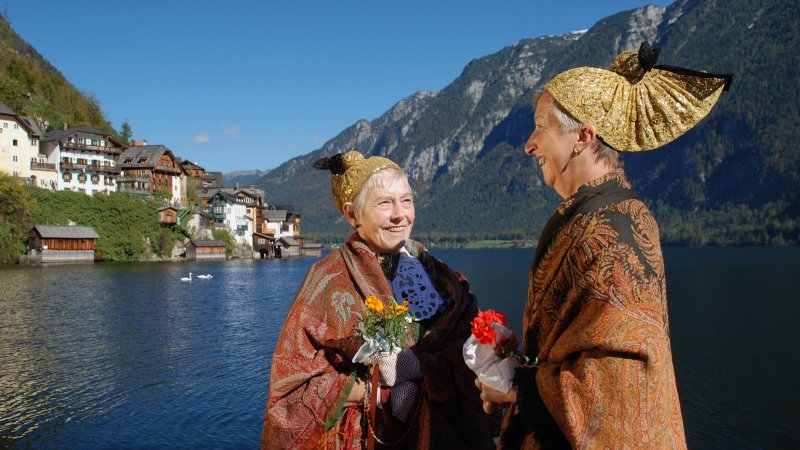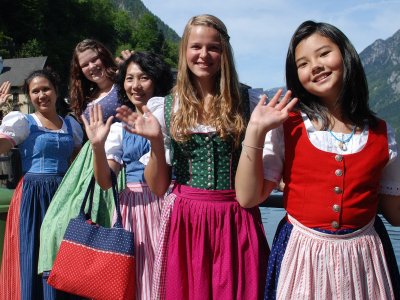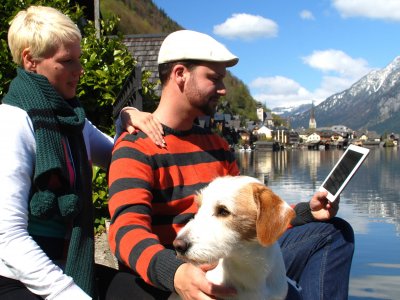UNESCO World Heritage region

The region around Lake Hallstatt – World Cultural Heritage
Located between the Wolfgangsee, Traunsee, Ebensee and Hallstättersee lakes, the Dachstein-Salzkammergut area (or: Inner Salzkammergut) comprises the villages of Bad Goisern, Hallstatt, Gosau and Obertraun. In 1997 most of the historic, cultural landscape was listed a UNESCO World Heritage Site – characterized by breathtaking views, mighty peaks and spectacular caves. The UNESCO World Heritage region of Hallstatt Dachstein Salzkammergut has always attracted both active and relaxation-minded travelers thanks to charming bathing lakes and unspoiled mountain scenery. With its bizarre ice caves, varied hiking routes and the Five Fingers viewing platform Dachstein Mountain is the most popular excursion site in the area. The Schönbergalm conservation area is not only home to the Cave Museum, but also the starting point for excursions to the Dachstein Ice Cave and the Mammut Cave, and therefore a highlight for families.
A visit to the ice cave will definitely change your perspective! The fascinating, subterranean world of ice and rock developed in the depths of Dachstein Mountain in the course of time. High above the Traun Valley qualified and experienced guides introduce adults and children to the highlights of the Dachstein Eishöhle ice cave, including ‘Eispalast’ and ‘König Artus Dom’. However, a holiday in the Dachstein-Salzkammergut region offers unparalleled nature experience above ground as well: Visit the Five Fingers platform for spectacular views of the mountains; explore the Schönbergalm nature reserve; or walk along the Heilbronner Rundwanderweg loop trail and leave dull everyday routine behind.
Your gateway to the mountains: One lift pass covers the Krippenstein Seilbahn in Obertraun and many other uphill facilities throughout the Salzkammergut. With the free Schladming-Dachstein Summer Card many local attractions are accessible for free or at discounted rates. Bad Goisern’s public beach at Lake Hallstatt lends itself to a refreshing soak on a hot summer’s day. Do not miss out on a visit to the picturesque village of Hallstatt an , but has also greatly increased their prosperity and brought with it certain priviliges. As a result, this little community has become world famous, and local people take pride in the fact that a whole period in history was named after them.
History of the World Heritage region around Hallstatt
A historical cultural landscape since thousands of years: The region around Lake Hallstatt appealed very early to humans looking for the vital salt. There are traces of salt mining on the Hallstatt Salzberg going back as early as 2000 B.C. Great prosperity was gained through the salt trade, the burial objects document extensive and wide spread trade relations. The climax of ancient mining was definitely from 800 until 400 B.C (older Iron Age), which is also referred as the Hallstatt-Period due to the numerous findings in Hallstatt.
The mine was affected by a part collapse later on. Around the time of Christ’s birth the area was ruled by the Romans who started to settle in the valley, while the local people continued their trade. During the 5th century with the end of the Roman dominance a cultural collapse took place. There is no sure evidence if there was any salt mining during the medieval times, except a few traces of possible salt production on the west side of the Sandling.
Around the turn of the 14th century we have reliable sources since the Habsburgs took over this area as their private property. Hallstatt regained its status as an important production site. The alliance between Austria and Bohemia in the 16th century resulted in a real boom era, and at the same time the region became dominated by Lutherans. Soon the mining capacity of Hallstatt became exhausted; the forests looked like karst formations, therefore the production had to be increased in Ischl and later on in Ebensee.
The Catholic counter-reformation was a disastrous era for the Inner Salzkammergut, resulting in the displacement of more than 700 Lutherans to Transylvania at its peak. Only in 1781 the long awaited religious toleration became a reality. Around 1800 tourism slowly developed in this region, and the first travellers wrote in their guidebooks about travelling through the “Austrian Switzerland”. Tourism really took off with the construction of the railway, making the area more accessible. Since then the Inner Salzkammergut is a most popular tourist destination, which also was internationally appreciated with the World Cultural Heritage nomination by the UNESCO. © Dr. Michael Kurz, Dez. 2002
Offers in the World Heritage Region
Excursion planner
There is so much to discover in the UNESCO World Heritage region of Hallstatt Dachstein Salzkammergut. Old mines, mighty cave worlds or spectacular glaciers at romantic lakes - a paradise for cultural- and nature lovers.
The World Heritage museum of Hallstatt
How did the people of Hallstatt live in the past? How did they earn their crust? The answers to these and other questions will be provided on a journey through time of the extra class in the heart of Hallstatt. Open all year!
All 4 one
Since living memory it was the salt which provided the wealth for the Inner Salzkammergut. The salt is the basis for the typical ancient customs and interesting cultural peculiarities. Recently UNESCO determined a big part of this region as a World Heritage worth to be preserved.
The region around Lake Hallstatt
Nowhere else will you experience so much natural variety and breadth of experience. With numerous crystal clear lakes and breath-taking mountain scenery, this "Hallstatt - Dachstein/Salzkammergut" region of outstanding natural beauty welcomes visitors time and time again.
The World Heritage speaks many languages
Information about the World Heritage region around Lake Hallstatt in french, Italian, hungarian, czech. All World Heritage Sites are excellent choices for an excursion beyond the ordinary.
School Project Week in the World Heritage region
Dachstein Salzkammergut | Welterbe-Aktiv: School trips usually require a lot of organisation: lengthy phone calls, complicated price tarifs... When you book with us, however, this is not the case. Everything is organised all in one go!
Videos from the World Heritage
Videos of the UNESCO World Heritage region of Hallstatt Dachstein Salzkammergut. A journey through all the seasons in moving pictures. Ideal to get you into the mood for your holiday on Lake Hallstatt.
UNESCO Convention
The "World Heritage Convention" was decided upon at the 1972 UNESCO General Conference, to select "natural and cultural heritages" and to record them in a "List of World Heritages", which is of exceptional interest and value for all of humanity.
Themed trails & Audio Guide Tour
By means of display boards and interactive elements, visitors learn a lot of interesting and useful information about this unique natural and cultural landscape within the UNESCO World Heritage region. Most themed trails can be enjoyed whatever the weather.
Wi-Fi hotspots within the World Heritage
Hallstatt & Co.| W-Lan-Hotspots: Twitter, Facebook posts, Emails during a holiday on Lake Hallstatt or in the Gosau Valley - not a problem. Free hotspots make it possible.
Guided Tours in the Salzkammergut
There is much to discover in the Salzkammergut. The best way to do this is to go on a tour together with the trained guide staff. There is something for everyone! Local history tours, hiking tours or guided tours through mines and caves. You have the choice and the pleasure!
Customs and traditions
Would you like to know more about tradition and customs? Here you can find out more about individual events and authentic folk culture. Interesting trivialities not found in any travel guide.
Tour from Nativity Scene to Nativity Scene
Around Christmas commences the time of the “Kripperlroas”. You can visit the most beautiful nativity scenes of the Salzkammregut by horse-drawn carriage, foot or boat.
Book tips and Games to the Salzkammergut
Fancy exciting stories and fascinating pictures? Whether you're a "reader" or a "re-reader", you'll find plenty of books and games about the Salzkammergut here. Games, fun, excitement and reading material for every weather!
Reformation in the Salzkammergut
When "false prayer" was dangerous and Luther's disciples were persecuted. History & Stories from the World Heritage Site. In addition, all events on the Reformation in the Salzkammergut. We've got you covered!
You might also be interested in
Highlights & theme worlds
In the Salkammergut Dachstein region there is plenty to see and do – at all seasons of the year. Here are the event highlights around the year!
Traditional Events in the Salzkammergut
Genuine and down-to-earth, varied and unusual - the traditional events in the Salzkammergut. This is how you get to know the country and its people! Come and see!
Summer of Culture in Gosau
On the mountains & in the valley. Customs and tradition at the Gosau Summer of Culture. The Gosau Valley presents. Under the title "Gosau Summer of Culture", the World Heritage community invites you to a varied programme of cultural and traditional events. Whether in the valley or on the alpine pastures - there is something for everyone. Look forward to numerous events in the picturesque Gosau valley.
Salzkammergut booking - Are you still looking for accommodation?
Hotels and accommodation providers in Hallstatt, Bad Goisern, Gosau and Obertraun offer the ideal room or apartment for your holidays, no matter what your tastes. Aside from establishments rated according to the international "star" scale, you will also find around Lake Hallstatt in Austria businesses that have been awarded two to four "edelweiss". The more flowers, the greater comforts you can expect. Whether you eventually find your cozy nest in an elegant 5-star luxury hotel, at comfortable guesthouse, a family-friendly apartment, or on a traditional farm, the choice is always entirely up to you.


















